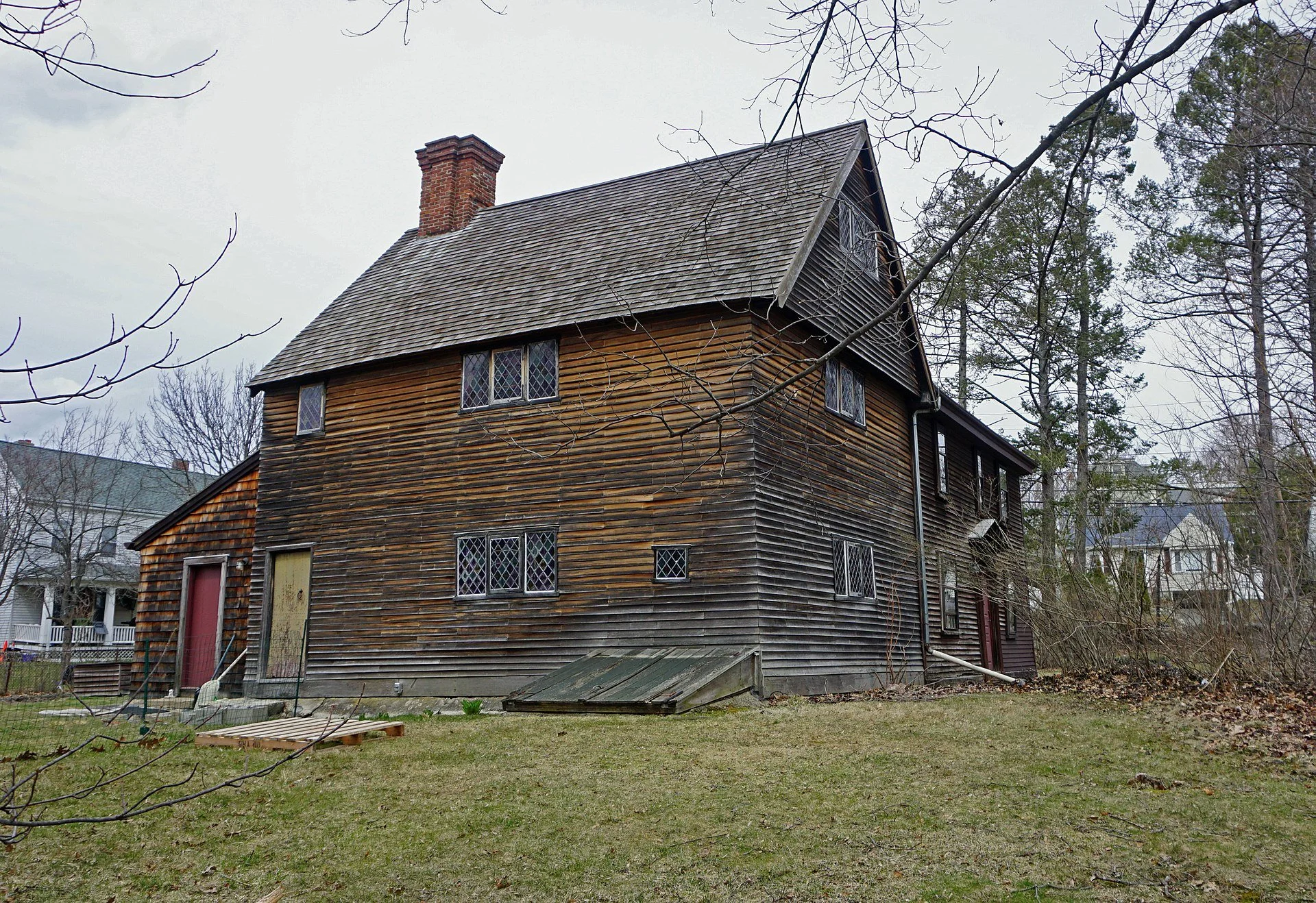
Not for kindling
“Untitled”’ (wooden sticks), by Charles Arnoldi, in the show “On the Edge: Los Angeles Art 1970s-1990s,’’ at the Armenian Museum, Watertown, Mass., through Feb. 26.
Argon art; this old house
“Portrait of Joan” (hand-blown and colored glass tubing, argon gas with mercury transformer), by Laddie John Dill, at the Armenian Museum, Watertown, Mass., in the show “On the Edge: Los Angeles Art 1970’s-1990’s’’
Abraham Browne House, in Watertown, built around 1694. It is now a nonprofit museum operated by Historic New England.
The house was originally a simple one-over-one dwelling and features steep roofing and casement windows, recalling many 17th Century English dwellings. During restoration work in 1919, details of 17th Century finish were found. The ground floor has one large room, which was used for as a sort of living room as well as for cooking and sleeping.
The building may be one of fewer than a half-dozen houses in New England to retain this profile.
— Photo by Wayne Marshall Chase
What colleges owe our democracy
The Seeley G. Mudd Building at Amherst College, the elite small liberal-arts college in the Massachusetts town of the same name that has abolished legacy admissions. The striking building, for math and computer science, was designed by Edward Larrabee Barnes and John MY Lee and Partners with Funds donated by the Seeley G. Mudd Foundation, named for a physician and philanthropist who lived from 1895 to 1968 and didn’t attend Amherst.
From The New England Journal of Higher Education, a service of The New England Board of Higher Education (nebhe.org)
WATERTOWN, Mass.
What Universities Owe Democracy; Ronald J. Daniels with Grant Shreve and Phillip Spector; Johns Hopkins University Press; Baltimore; 2021.
When the president of a major university publishes a deeply researched, closely reasoned, strongly argued powerful idea and call to the profession to respond to an urgent crisis in our national history, it is highly likely to become a classic in the literature of higher education. Ronald Daniels, president of Johns Hopkins University (co-authoring with colleagues Grant Shreve and Phillip Spector), has accomplished that with this new book, appropriately entitled What Universities Owe Democracy.
The New England Journal of Higher Education has responded to the widely recognized “epistemic crisis” in our democracy in two previous articles this year. The first, in April, unpacked the economic, technological, psychological and moral aspects of the problem, to focus on higher education’s purview of epistemology, and contended that it is incumbent upon all public educators—including journalists and jurists—from secondary schools onward, to insist that “thinking on the basis of evidence” is the only reliable way to establish and use the power of knowledge in any field. The second, in September, was a critical review of the journalist Jonathan Rauch’s recent book, The Constitution of Knowledge, asserting that he offered not a solution but part of the problem—that the epistemic crisis in public (or popular) knowledge, Rauch’s actual subject, is exacerbated by journalism’s misconceived habit of promoting as criteria of truth broad public acceptance and trust, rather than thinking on the basis of evidence.
The fundamental issue underlying both those articles—that scholars and scientists have civic responsibility—has now been addressed by Daniels, who has been previously known as a leading advocate for eliminating legacy admissions at prestigious institutions, which he did at Hopkins in 2014. His example was followed by a few others, most recently Amherst College.
The excellence of his book derives from his extraordinary idealism for higher education and the essential, indispensable role of colleges and universities in what he carefully defines as “liberal democracy.” His basic argument is that the welfare of American universities and of democracy have historically been and are strongly interdependent, so it is now necessarily in the academy’s interest to defend democracy from subversion. He poses as the “relevant question,” “How does the university best foster democracy in our society?”
His answer is painstakingly developed. Each of the book’s four chapters features careful definition of terms, a highly informative history of the chapter’s specific issue in American higher education, an analysis of its current challenges, and the author’s policy recommendations. The discussion is lucid, intellectually rigorous, and considerate of the complexities involved. This brief review cannot do justice to his detailed arguments, so I shall highlight a few points of broad interest.
A leitmotif throughout the book is what Daniels calls “liberal democracy,” which he defines in detail as an Enlightenment ideal: “liberal” in favoring individual freedom, “democracy” in promoting political equality and popular sovereignty. Whereas the two can occasionally conflict, society’s common good depends on their equitable balance. On these ideals, he writes, the United States is predicated.
The first chapter focuses on the “American Dream” of social mobility for this (in JFK’s phrase) “nation of immigrants.” Daniels elucidates the pre-eminent role universities have played in promoting it; no other institution, he says, has been throughout our history and still today more influential in that essential function. “Universities are one of the few remaining places where Americans of different backgrounds are guaranteed to encounter one another.” Therefore, colleges and universities must ensure that everything they do contributes to social mobility. This is where the issue of legacy admissions arises—about which, see more to follow.
The next chapter, “Free Minds” concerns civic education. Citizenship must be cultivated; it is not an innate trait. This used to be done by civics courses required at the high school level but in recent decades, that has languished, yielding ground to the rise of science and separate specialized disciplines. Today, only 25% of secondary schools require civic education, but because 70% of students go on to some form of postsecondary education or training, that is where, by default, civic education must be revived. Daniels advocates a “renaissance in civic learning” to reaffirm how the Founders envisioned higher education in our democracy. Noting that robust civics education is unlikely to be recovered by high schools in today’s polarized political environment, he presents a strong historical case for the inclusion of promoting democratic citizenship in higher education. Acknowledging the wide diversity of institutional types and cultures in postsecondary education today, he encourages every institution to develop its own approach.
Daniels then turns to the central role of universities in the creation, promotion and defense of knowledge, upon which liberal democracy is necessarily based. American universities have uniquely combined within single institutions their own undergraduate colleges, professional graduate schools, research facilities and scholarly publishing, protected by academic freedom and tenure. This powerful and mutually reinforcing combination has produced intellectual leadership in our liberal democracy. All this has been potently challenged, however, by developments in modern philosophy (linguistic analysis and epistemology) and more recently information technology (computers, the internet, social networks and artificial intelligence). Daniels courageously addresses these extremely complex and subtle issues (e.g., post-structuralism) in detail. His discussion is enlightening and supports his thesis that universities have a crucial role to play in intellectual leadership, “building a new knowledge ecosystem” that will protect and strengthen liberal democracy.
The next chapter “Purposeful Pluralism” discusses how colleges and universities may promote both greater diversity in their student bodies and genuine mixing of their constituencies by cultivating more inclusive communications and mutual understanding. But while greater diversification has been increased by deliberate admissions strategies, there needs to be sustained follow-through in the infrastructures of student life—in housing and rooming arrangements, dining, socializing, curricular and extracurricular settings, including faculty-student interactions and intellectual life in general. “Our universities should be at the forefront of modeling a healthy, multiethnic democracy.”
He concludes then by reviewing the overall argument, its urgency, and “avenues for reform,” which include: 1) End legacy admissions and restore federal financial aid, 2) Institute a democracy requirement for graduation, 3) Embrace “open” science’ with guardrails and 4) Reimagine student encounters on campus and infuse debate into campus programming. “The university cannot, as an institution, afford to be agnostic about, or indifferent to, its opposition to authoritarianism, its support for human dignity and freedom, its commitment to a tolerant multiracial society, or its insistence on truth and fact as the foundation for collective decision-making,” Daniels writes. “It is hardly hyperbole to say that nothing less than the protection of our basic liberties is at stake.”
While I may not completely agree with all the positions Daniels takes, I strongly believe that every academic reader will find this book highly illuminating, practically useful, and I hope, compelling. One relatively minor point of difference I have is where today’s vexed issue of legacy admissions is directly addressed. Daniels acknowledges that though the numbers of admissions decisions involved is relatively small, their symbolic significance is large, especially owing to the prominence of the institutions involved. The practice is followed by 70 of the top 100 colleges in the U.S. News rankings and, though it affects only 10% to 12% of their comparatively small numbers of students, it sends a message that is widely interpreted as elitist and undemocratic. Daniels focuses more on opposing the message than upon analyzing the practice in detail, and he provides no hard data on the process or results of the elimination of the policy anywhere.
This stood out for me as an odd departure from his usual data-intensive analytical habit. One reason for its exception is that he considers the message more important than the practical details, but another might be that data have not yet shown the abolition of legacy admissions to have significant practical impact on social mobility. Still another might be that, as I understand it, the reasons for which legacies were created are not the reasons for which they should now be abolished. They were instituted and are maintained primarily for internal institutional purposes—i.e., to encourage alumni engagement and fundraising—and not for any public message.
Here we may connect a few separate dots, not presented together in the book. Daniels abolished the practice at Hopkins in 2014 but did not announce it publicly until 2019. In that interval, he also sought and secured in 2018 a sensational gift from Hopkins alumnus Michael Bloomberg, of $1.8 billion for student financial aid. While it is understandable that Daniels would be reluctant to discuss this historical process in detail, or whether it was planned from the start and enabled by a unique advantage Hopkins had with Bloomberg as an alumnus, it is also conceivable that the Hopkins decision was not problem-free, and that the extremely generous grant was invoked as a solution.
In any case, avoiding the practical issue in the book also avoids considering a possible (though admittedly unforeseeable) solution for other institutions now—i.e., taking advantage of the unprecedentedly high multibillion-dollar gains in 2020 endowment yields and personal capital to use them separately or together to make major investments in student financial aid. This may, in other words, be an opportune time to modify legacy policies—perhaps to retain them in some refined or reduced form as an instrument supporting both student diversity and strengthening alumni relations and fundraising, while heading off the public impression of elitism.
The world is changing fast, and it is essential that universities keep up the pace. Political reform is slow and now especially cumbersome, whereas the only impediment to universities adapting and leading is the will to do so. That is where a book such as this can exert palpable influence, and considering how rare it is for such a book to be written, are we not in turn professionally obliged at least to read and think about it?
George McCully is a historian, former professor and faculty dean at higher education institutions in the Northeast, professional philanthropist and founder and CEO of the Catalogue for Philanthropy, based in Watertown, Mass.
'Creation and destruction'
“Glory in the Celestial Flower’’ (mixed media and acrylic on plaster panel) by Isabel Riley, in her joint show with Lynne Harlow entitled “GLOW,” at Drive-by-Projects, Watertown, Mass., through Aug. 14.
The gallery says: “Riley's painting … are equal parts creation and destruction as she alternates between building surfaces up and scrubbing them down. She does this in the pursuit of imagined, subconscious spaces and dynamic color.”
‘Muscles must be used’
Helen Keller (left) in 1899 with companion and teacher Anne Sullivan. Photo taken by telephone inventor Alexander Graham Bell at his School of Vocal Physiology and Mechanics of Speech, in Boston.
“All the wondrous physical, intellectual and moral endowments, with which man is blessed, will, by inevitable law, become useless, unless he uses and improves them. The muscles must be used, or they become unserviceable. The memory, understanding and judgment must be used, or they become feeble and inactive. If a love for truth and beauty and goodness is not cultivated, the mind loses the strength which comes from truth, the refinement which comes from beauty, and the happiness which comes from goodness.’’
— Anne Sullivan (1866-1936), teacher and lecturer, in her 1886 commencement address at the Perkins School for the Blind. Founded in 1829 and now in Watertown, Mass., it’s the oldest school of its kind in the United States. Ms. Sullivan, who was mostly blind, is most famous as the teacher of Helen Keller (1880-1968), the blind and deaf author, lecturer and political activist who was a household name in America for much of her adult life. The relationship between the two women was memorialized in the play and movie The Miracle Worker.
Too bad that the students can’t see it: The Howe Building Tower at the Perkins School for the Blind's campus, in Watertown, Mass.
Comfort in isolation
From the show of oil paintings on panels by Donna Calleja called “Close to Home, ‘‘ at the Room 83 Spring gallery, in Watertown, Mass., through Oct. 31.
She told the gallery:
‘‘Most of the paintings in ‘Close to Home’ were created in 2020 in a small workspace in my home. The act of painting each afternoon provided me with comfort during this difficult time of isolation... . My goal is to interpret the beauty I see in the small details of everyday objects and I hope to provide my viewers with a sense of calm and quiet reflection.’’
The gallery said: “Her compressed arrangements of domestic objects expertly balance color, shadow, light and composition in this series of small luminous still lifes.’’







